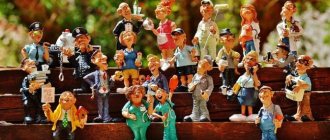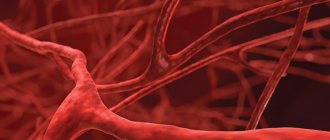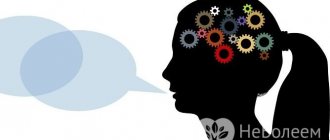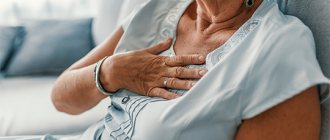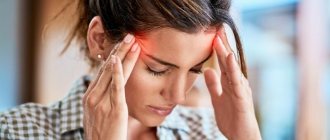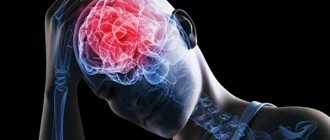Stroke is a dangerous condition characterized by impaired cerebral circulation. Brain damage of this type is the most common cause of disability, and also occupies a leading position as a cause of mortality, second only to myocardial infarction and cancer.
Neurologists distinguish between ischemic stroke, the prevalence of which is more than 80% of the total number of cases, and hemorrhagic stroke, diagnosed in 20% of cases.
In most cases, the development of stroke is associated with blockage of the lumen of a cerebral artery by a thrombus. The quality of life and prognosis are determined by many factors, among which the most important is the adequacy and timeliness of care provided to the patient. Neurologists at the Yusupov Hospital provide emergency care to patients with signs of stroke, and also carry out comprehensive examination, treatment and rehabilitation measures.
First symptoms
A stroke is characterized by a lack of nutrients and oxygen in the brain tissue. The causes of this phenomenon are: rupture, blockage or compression of a cerebral vessel. Women and men require emergency assistance when the first signs of a stroke appear:
- sudden dizziness and headache that occur for no apparent reason;
- confusion;
- visual impairment, speech impairment;
- uncoordinated movements, gait disturbance;
- numbness, weakness in the limbs on the affected side.
Patients who have suffered a stroke resemble people who are intoxicated. The following requests can be used to identify an acute condition:
- stick out your tongue, in case of a stroke the tongue will fall to the side;
- smile; when smiling, facial asymmetry may appear;
- utter a simple phrase, after a stroke the patient is unable to speak;
- raise your arms, this action is aimed at identifying asynchrony of movements and weakness of the limb on the affected side.
The listed signs are a serious reason to call an ambulance. After a stroke, the patient’s life is in danger, so treatment measures must be organized in the shortest possible time. Neurologists draw patients' attention to the fact that during a microstroke or ischemic attack, similar symptoms may also occur, but they are less intense and pass quickly.
Stroke: how to recognize and determine brain damage
Doctors emphasize that in the first three to six hours after the onset of hemorrhage, the most effective treatment and removal of a person from a fatal condition is possible. Every second counts, and this is not an exaggeration - this is why it is very important to know and be able to determine whether a person is having a stroke in order to immediately take him to the hospital or call an ambulance.
The following sensations and complaints should raise suspicion:
- sudden weakness in the limbs;
- numbness in the arm and leg on one side;
- severe speech impairment;
- confusion or loss of consciousness;
- impaired perception of the speech of people around;
- loss of coordination, balance;
- feeling dizzy;
- sharp and sudden headache after a stressful condition or severe physical exertion;
- numbness of the lips, half of the face, distortion of the facial muscles;
- violation of pressure indicators - a sharp decrease or increase.
What should you do if the person next to you becomes ill, and how can you tell if he is having a stroke? There are 4 tips that help to almost accurately determine that a deterioration in well-being occurred precisely against the background of this pathology:
- Ask him to smile - if he has been struck by a stroke, the patient will not be able to do this or he will have a crooked grin on one side, while the second corner of his mouth will remain motionless or will react inhibited.
- Ask to answer a simple question - what day is it today or what is his name. A person will not be able to pronounce a simple sentence of several words, his speech will be slowed down, words and letters will change places. Or there will be no response to the request at all.
- The patient is asked to raise both arms up - he will also not be able to do this, his arms will only rise partially. There is muscle weakness on the affected side.
- Ask to stick out your tongue. If it is curved, then this may be a sign of pathology.
If a person suspected of having a stroke has problems performing at least one of the simple tasks listed, he urgently needs to be taken to the hospital, or call an ambulance.
Other obvious symptoms that the victim complains about are severe headaches, the appearance of flashing “spots” before the eyes, numbness of the limbs and loss of sensitivity. The person should be asked to move their left and right limbs together; they will likely find it extremely difficult to do so.
Nausea, vomiting and dizziness are common; vision disappears, coordination of movements is impaired. The patient cannot stand on his feet, falls, and loses consciousness.
Signs of ischemic and hemorrhagic stroke
A stroke, depending on the mechanism of its occurrence, can be ischemic or hemorrhagic, the first signs of which are significantly different. Hemorrhagic stroke has symptoms such as headache, impaired consciousness, dizziness, convulsions and vomiting. This type of stroke is characterized by focal symptoms:
- cranial nerve palsy;
- bulbar, meningeal and pyramidal symptoms;
- speech dysfunction;
- decreased sensitivity.
With hemorrhage in the brain, general cerebral symptoms first appear, which are then combined with focal signs of the disorder.
The development of ischemic stroke occurs rapidly, within a few seconds. Ischemic stroke is characterized by focal neurological disorders in which speech, motor, and cognitive functions are affected. If the cerebellum or brainstem is affected, there is a sharp headache, confusion and intense vomiting.
Neurologists conduct an examination and instrumental diagnostics to identify the type of stroke in a patient.
The first signs of myocardial infarction: when to take action?
Myocardial infarction is an acute condition that occurs due to coronary heart disease and is accompanied by severe circulatory failure in the coronary vessels and necrosis of part of the heart muscle tissue. In 10–12% of cases it is life-threatening for the patient. More often, heart attacks occur in men over 60 years of age, but after menopause, women are also at risk. In recent years, there has been a significant “rejuvenation” of this condition and the development of anesthesia of the heart muscle in 20-30 year old young people is observed more and more often.
In 90% of patients with coronary artery disease, a heart attack is provoked by coronary artery thrombosis caused by atherosclerosis. The following reasons can also provoke coronary circulatory insufficiency:
- thrombosis and spasm of coronary vessels;
- heart injuries;
- tumors or metastases.
- The risk group for developing a heart attack includes people with the following pathologies and conditions:
- atherosclerosis;
- hypertonic disease;
- obesity;
- diabetes;
- increased levels of LDL in the blood;
- adynamia;
- bleeding disorders;
- smoking and alcoholism;
- excessive psycho-emotional and physical stress.
Usually the attack begins suddenly, but in some patients there may be a pre-infarction condition, manifested by an increase in temperature, tachycardia and arrhythmia, cyanosis of the mucous membranes, severe pallor, an increase in blood pressure with its subsequent decrease. This condition can last from several hours to several days or weeks.
The main sign of a heart attack is severe pain in the chest, which is prolonged. It differs from the pain that occurs with angina pectoris in that it manifests itself for more than 15 minutes and is not eliminated even by repeated administration of Nitroglycerin. Usually pain occurs after physical or psycho-emotional stress.
Immediate first aid actions for a heart attack should be performed immediately after the following symptoms occur:
- severe and prolonged pain behind the sternum of a burning, stabbing, tearing, squeezing nature (it is present for half an hour and is not eliminated or is only partially relieved by the usual intake of Nitroglycerin);
- severe anxiety and fear of death;
- pain radiates to the left (sometimes to the right) arm, shoulder blade, interscapular area, neck, teeth;
- cold clammy sweat;
- dizziness or fainting;
- pallor;
- nausea;
- difficulty breathing and shortness of breath (sometimes);
- rapid and arrhythmic pulse.
In approximately 20% of cases, myocardial infarction occurs in an atypical form and is not accompanied by pain in the heart area. In such cases, symptoms may be as follows:
- with an atypical location of pain - it is concentrated in the left hand, at the tip of the little finger of the left hand, in the cervicothoracic spine or in the scapula, in the area of the lower jaw or neck, the pain syndrome is complemented by typical manifestations of a heart attack;
- with the gastric type of attack - indigestion and abdominal pain;
- with asthmatic – shortness of breath and suffocation, dry cough;
- with arrhythmic – rapid and arrhythmic pulse;
- with cerebral – confusion, dizziness, nausea and vomiting, speech disorders;
- with edema – severe weakness, shortness of breath, rapid increase in edema;
- if painless - discomfort in the chest, weakness, increased sweating.
The first signs of a heart attack and any suspicion of its development are a reason to call an ambulance. The operator must be informed about the symptoms and the possibility of a heart attack. After this, you should immediately begin providing pre-hospital emergency care.
Emergency help
The stable functioning of brain structures is ensured by metabolic processes characterized by high speed. Irreversible changes in the affected area during a stroke occur due to a violation of their mechanism. The area affected by a stroke is outlined by a penumbra formed by cells that can be restored with adequate and modern therapeutic measures. The patient’s quality of life and the effectiveness of rehabilitation measures depend on how successfully first aid is provided.
It is possible to restore the functioning of some cells within 4 hours after the first signs of an acute disorder appear. At the moment, the support of loved ones and relatives is of particular importance, since patients often do not realize the events happening to them. When symptoms of a stroke appear, loved ones should not only call an ambulance, but also provide first aid, regardless of where the person is: at home or on the street.
First aid for hemorrhagic and ischemic stroke involves performing the same actions. After calling an ambulance, it is important to understand whether the person is conscious, since with severe lesions, patients fall into a coma; epileptic seizures and stupor are also possible. If there is no response, it is important to periodically bring the patient to consciousness, as well as ensure his safe placement.
Another vital point is to check the person's heartbeat and breathing. In some cases, the patient’s life can be saved by resuscitation measures carried out before the doctors arrive. If a person breathes on his own and his heart is beating, then he should be laid on his back or side, to ensure air flow, his neck and chest should be freed from constricting clothing and accessories.
When a patient wears removable dentures, they should be removed from the oral cavity. Vomiting during stroke is common and can obstruct the airway, so it is important to remove the vomit while the patient is unconscious.
The next step in first aid is to check the blood pressure level, if it is elevated, you should not give the person water or any medications. Before doctors arrive, paralyzed limbs should be massaged and the person covered with a blanket.
The participation and care of people around you can save a person’s life. The adequacy and efficiency of first aid provided determine the effectiveness of subsequent treatment and rehabilitation measures. After the ambulance arrives, the patient is hospitalized in a medical facility equipped to combat the consequences of a stroke.
FIRST MEDICAL AID FOR STROKE lesson plan on life safety (grade 10) on the topic
Lesson topic
FIRST MEDICAL AID FOR STROKE
Author: Pautov A. M.
Goal: to introduce students to the concept of “stroke”, the causes of its occurrence, and the rules of first aid for a stroke.
Equipment: diagrams of the blood circulation, cardiovascular system, heart (diagrams from the textbook or on separate sheets of visual material in the biology classroom).
During the classes
- Organizing time.
- Repetition of material.
1. Conversation:
Repetition of knowledge from a biology course on the topic “Cardiovascular system”.
Questions for the conversation:
— What is the cardiovascular system and what is its importance? (This is the only system that ensures blood circulation in the body and blood supply of organs and tissues with oxygen and nutrients.)
-What is the heart? (The heart is an organ of the circulatory system that creates the energy for blood movement.)
— What role do blood vessels play in the body? (Blood vessels are elastic tubes that form a closed blood circulation system from the heart to all organs and tissues and back (divided into arteries and veins). Arteries carry blood from the heart to the tissues, gradually turning into arterioles, capillaries, venules, small veins and large veins that carry blood back to the heart).
— How is heart failure characterized? (Heart failure is a pathological state of circulatory failure due to a decrease in the pumping function of the heart. Causes are diseases and overload of the heart muscle. It is divided into acute, which occurs suddenly or almost suddenly, and chronic, which develops over several weeks, months or years.)
The teacher recalls the concepts: “heart”, “blood vessels”, “heart failure” and “stroke”.
Using diagrams, students show the direction of blood flow, the activity of the cardiovascular system and the work of the heart.
2. Analysis of a specific situation (CAS).
Teacher. After reading a real case from judicial practice, analyze it by answering the questions written on the board:
— In the situation described, are there signs of necessary defense, an urgent need to detain the criminal?
— What are the conditions for the legality of causing harm?
— Are the conditions for the legality of causing harm met in this case?
— Were the limits of necessary defense exceeded?
— If the conditions of legality are not met, then how is this specifically expressed? List the violations, their conditions, give the AKS.
— What is the responsibility of persons who did not comply with the conditions of legality?
3. Test work “What can the pulse tell you?”
Task: complete the sentences (to be done in writing).
- Pulse rate is measured by __________________________________________.
- Normal pulse: the child has _______________________________________,
for men____________________, for women____________________.
- Changes in heart rate are caused by ________________________________.
- A rapid or weak (irregular) pulse indicates _________________
_______________________________________________________________,
and in a person at rest, on ______________________
_______________________________________________________________
- A slow heart rate indicates _____________________________________
________________________________________________________________.
Answers: number of beats per minute; up to 90 beats per minute, from 60 to 80 beats per minute, from 78 to 82 beats per minute; various diseases and injuries; for shock, internal hemorrhage, overheating, cardiac dysfunction; to hypothermia of the body.
- Studying a new topic.
1. Explanation-story by the teacher.
Teacher. Stroke (apoplexy - cerebral stroke) is an acute disorder of blood circulation in the brain, causing death of brain tissue (cerebral hemorrhage), caused by mental or physical overload of the body. (Students write down the definition in their notebook.)
A sedentary lifestyle, stressful situations, smoking, obesity, and dehydration contribute to the development of stroke. A stroke is accompanied by a disturbance of consciousness lasting from several hours to several days.
Signs: paresis, paralysis. Sensitivity disturbances, dizziness, confusion, speech and vision disturbances.
Giving help:
- It is necessary to create peace and carefully undress the patient.
- Lay the patient (if conscious) so that the head and shoulders are slightly elevated.
- Open a window or window.
- Give a teaspoon of cordiamine to drink.
- Turn the patient's head to the side and make sure that he does not hurt himself so that saliva can flow freely from the mouth.
- To prevent tongue bite, insert the handle of a spoon wrapped in a handkerchief or gauze between the molars. Make sure your tongue doesn't stick.
- Clear the patient's mouth of mucus with a finger wrapped in a handkerchief.
- Call an ambulance.
- If breathing and cardiac activity have stopped, perform indirect cardiac massage and artificial respiration.
You have heard more than once about the terminal condition of the victim. What does this concept include? (This is a condition related to the final stage of life with a reversible state of decline of the organism.)
In case of a terminal condition, we are not talking about first aid. In this case, emergency assistance is the revival (reanimation) of a dying person. Experienced specialists perform cardiac massage and artificial respiration.
2. Analysis of the algorithm.
Teacher. Review the assistance algorithms and comment on them.
ALGORITHM FOR PROVIDING HELP
if the victim has no signs of life
ALGORITHM FOR PROVIDING HELP
victim in a coma
ALGORITHM FOR PERFORMING A PRECARDIAL STROKE
and indirect cardiac massage
WHAT YOU NEED TO REMEMBER WHEN PERFORMING INDIRECT HEART MASSAGE
- You cannot stop chest compressions even if you have a rib fracture.
- Do not interrupt chest compressions for more than 15-20 seconds.
- You cannot stop resuscitation if there are signs of its effectiveness, such as constriction of the pupils and pinkening of the skin, but in the absence of a pulse in the carotid artery.
ALGORITHM FOR PROVIDING HELP
after revival
WHAT SHOULD BE DONE TO MAKE RESUSCITATION EFFECTIVE AND REDUCE THE PROBABILITY OF DEVELOPMENT
CEREBRAL EDEMA
- Apply cold to your head.
- Apply pressure with your fists on the abdominal aorta throughout resuscitation.
WHAT YOU NEED TO DO TO SAVE
THE LIFE OF THE SAVED
- Be sure to call an ambulance.
- Do not stop monitoring the victim’s condition for a second.
- Be ready to begin resuscitation again at any time.
- If spontaneous breathing and a pulse in the carotid artery appear, but the victim still does not regain consciousness, be sure to turn him on his stomach and apply cold to his head.
3. Practical training.
Students practice artificial respiration skills in pairs under the guidance of a teacher and following his recommendations and instructions.
- Lesson summary.
Teacher. Draw conclusions on the topic of today's lesson. What should be understood by “terminal state”? What are the possibilities for revitalizing the body? What components make up the cardiopulmonary resuscitation technique?
Homework: find a definition of the types of strokes, identify their differences and forms of the disease, as well as the rules for providing first aid for a stroke.
First aid for stroke
For ischemic stroke, if the patient was taken to the hospital within the first 4 hours, thrombolysis is performed using a plasminogen activator substance. The drug urokinase is used when there are indications for intra-arterial thrombolysis. The introduction of warfarin is possible after overcoming the acute period; this drug prevents recurrent stroke. To patients diagnosed with ischemic stroke, neurologists administer cardiomagnyl, ACC thrombo and aspirin-cardio.
With the development of cerebral edema, the efforts of specialists are aimed at reducing body temperature, eliminating oxygen deficiency in tissues and reducing the concentration of carbon dioxide in the blood. First aid for cerebral edema resulting from a stroke is carried out:
- hyperventilation;
- intravenous administration of drugs that have a dehydrating effect;
- drainage of cerebrospinal fluid;
- a surgical procedure during which the surgeon opens the skull and removes part of the bone, resulting in access to the brain.
First aid for hemorrhagic stroke is aimed at maintaining the patient’s vital functions. In this case, a minimally invasive or neurosurgical operation can achieve a positive result.
Signs of a stroke
Stroke can be hemorrhagic (bleeding in the brain) or ischemic (death of brain cells, also called cerebral infarction).
Signs of a hemorrhagic stroke are:
- Severe headache, confusion or fainting.
- Sudden vomiting, drooling.
- Decreased hearing and vision.
- Paralysis of half the body, distortion of facial expressions.
Signs of an ischemic stroke include:
- Dizziness.
- A feeling of weakness and numbness in the limbs, which gradually increases.
- Confusion of speech, distortion of words, lack of coordination of movements.
- Decreased visual acuity.
- Facial distortion.
- Cramps.
In both cases, a stroke develops within minutes. The signs of a hemorrhagic stroke are more pronounced. As a rule, the patient cannot answer questions. With an ischemic stroke, the patient first feels a slight discomfort, and here it is necessary to carry out several simple tests: ask to smile, raise your hands, read a line in small print. If the patient has one corner of his mouth drooping, it is difficult for him to move his limbs, or vision problems begin, it is necessary to call an ambulance. Ischemic stroke is more common, accounting for about 85% of cases.
Currently, special information brochures are being published with instructions for self-diagnosis of acute cerebrovascular accident. It is useful for everyone to become familiar with them. Remember that you can help not only your loved ones, but also random people in transport or on the street; such cases are not uncommon. The patient may not attach importance to his illness, resist testing and calling an ambulance, which often leads to death within a few hours. The importance of prompt diagnosis should be calmly explained. In such cases, special attention is required for people with hypertension, as well as the elderly.
Medical care at the Yusupov Hospital
At the Yusupov Hospital, we are ready to provide specialized care only on the third day. We do not provide emergency hospitalization for stroke.
If necessary, our employees are ready to quickly arrange the transfer of a patient from one medical institution to ours.
At the Yusupov Hospital, patients are supervised around the clock by medical staff and receive proper treatment, care and subsequent rehabilitation.
One of the structural divisions of the Yusupov Hospital is the neurology clinic, where patients receive highly effective medical care, professional care and comprehensive restoration of lost functions. Neurologists know how to combat even severe forms of the disease, so they do not refuse help to such patients.
By calling the Yusupov Hospital you can find out the procedure for hospitalization, call an ambulance, or make an appointment with a neurologist.
Make an appointment
What should be done first when a person has a stroke?
Advertising:
Wherever the stroke occurs and no matter what the stroke is, both the patient himself (if his condition allows) and those around him must act according to a clear algorithm:
- Do not panic!!!
- Assess the patient’s general condition: consciousness, breathing, heartbeat, blood pressure.
- Identify the obvious signs of a stroke: unilateral paralysis of an arm and leg, a distorted face, speech impairment, lack of consciousness, convulsions.
- Call an ambulance by calling 103!
- Find out the circumstances of the illness (briefly if possible).
- Provide resuscitation measures (artificial respiration, cardiac massage), but only if they are necessary (lack of breathing, heartbeat and dilated pupils).
- Position the patient correctly - on his back or side, either with his head and torso slightly elevated, or strictly horizontally.
- Provide conditions for good oxygen access to the lungs and blood circulation throughout the body.
- Monitor the patient's condition.
- Arrange transportation to the nearest hospital.
The emergency care described above is general and does not include some situations that are possible during a stroke. The sequence of events does not always have to be strictly the same as in the given algorithm. In case of critical impairment of the patient's condition, one has to act very quickly, performing several actions simultaneously. Therefore, if possible, 2-3 people should be involved in providing assistance. In any case, following the algorithm, you can save the patient’s life and improve the prognosis for recovery
Comprehensive examination of patients
An examination using high-precision and sensitive equipment at the Yusupov Hospital is carried out upon admission of patients with signs of stroke. A comprehensive diagnosis of a patient’s condition may include both computed tomography and magnetic resonance imaging. However, to exclude hemorrhage, the first-priority method is CT, since it is the fastest test.
MRI results allow the doctor to determine the source of the disorder and its size. This method helps visualize small lesions localized in the brainstem and cerebellum. When performing CT, these lesions are poorly visualized.
A comprehensive examination after a stroke at the Yusupov Hospital may also include:
- multislice tomography;
- angiography;
- magnetic resonance angiography;
- duplex scanning of the carotid and vertebral arteries;
- transcranial Dopplerography of arteries.
Specialists at the diagnostic center of the Yusupov Hospital record an electrocardiogram to detect ischemia, heart rhythm disturbances and myocardial disorders. Transthoracic electrocardiography is performed if intracardiac thrombus, cardiomyopathy and ventricular aneurysm are suspected.
Stages of treatment
The Yusupov Hospital treats patients after stroke in accordance with international standards.
- First stage.
Basic therapy is based on the organization of round-the-clock care, which involves the prevention of pulmonary congestion, bedsores and mobility impairment.
- Second phase.
The next stage of recovery is activities that involve passive movements in the joints. Breathing exercises are also of particular importance. If swallowing disorders are detected, the patient is given intravenous mixtures that provide the body with nutrients.
- Third stage.
Highly qualified neurologists create individual treatment programs that involve drug therapy and the use of non-drug methods. In case of arterial hypertension, patients are prescribed antihypertensive drugs.
An important area of treatment for patients after acute circulatory disorders is the regulation of water-salt balance in the body, osmolarity of blood and urine, and electrolyte content, for which infusion therapy is organized. Drug treatment may also include the use of glucocorticoids and diuretics for cerebral edema. Patients who have suffered a stroke, in the absence of contraindications, are prescribed anticoagulants.
The use of thrombolytic drugs by neurologists is carried out to restore blood flow and dissolve formed blood clots. Data from modern studies confirm the high efficiency of recombinant tissue plasminogen activator, which provides thrombolysis.
Neuroprotection
When the symptoms and first signs of a stroke first appear, the brain tissue has already been experiencing a lack of blood supply for some time. It needs to restore normal blood flow, full access of oxygen and nutrients to cells and increase their resistance to hypoxia. Hypoxia
A decrease in oxygen content in the body or individual organs and tissues. All these tasks are helped by therapy with neuroprotective drugs.
Neuroprotective drugs.
Drugs that prevent damage to the nerve cells of the brain from adverse effects. Their influence is aimed at eliminating or reducing disturbances in nerve cells.
Neuroprotection in stroke is aimed at inhibiting and stopping the sequence of stroke-damaging processes, which is also called the ischemic cascade Ischemic cascade
The sequence of reactions that occur in brain tissue when blood flow is disrupted. In a recent
stroke, signs and symptoms usually do not distinguish the ischemic type of lesion from the hemorrhagic one.
Therefore, it is necessary to start early neuroprotection in any case, as it will help to significantly reduce the consequences of the problem and reduce the risk of disability in any type of stroke. It is advisable to start neuroprotection as early as possible, even before the ambulance arrives. Almost every drug used for stroke is given intravenously to protect brain cells. The patient’s relatives cannot administer such drugs to him on their own. Semax 1%, which is created in the form of nasal drops, helps solve this problem.
Rehabilitation
In modern medicine, there are stages of the post-stroke period, according to which treatment and rehabilitation are organized:
- the first 3-4 weeks belong to the acute stage;
- the first 6 months form the early recovery stage;
- period from 6 months to 1 year – late recovery stage;
- The residual stage lasts more than 1 year.
The periodization of the early recovery stage includes two intervals:
- during the first interval, the duration of which reaches 3 months, a cyst is formed, strength and movement are restored in the paralyzed limbs;
- the second stage, lasting from 3 to 6 months, is the period of restoration of motor function.
Rehabilitation after a stroke at the Yusupov Hospital
At the Yusupov Hospital, rehabilitation activities begin early. All necessary activities are organized by a multidisciplinary team of doctors.
Data obtained during a comprehensive examination about the degree of damage and dysfunction allow specialists to create an individual rehabilitation program.
- Early start of rehabilitation.
Rehabilitation activities can be organized in the first hours after the patient’s admission to the Yusupov Hospital.
In this case, passive gymnastics and massage are performed. Early recovery reduces the likelihood of patient disability and reduces the severity of symptoms and complications. - 24/7 monitoring.
Specialists at the Yusupov Hospital monitor the patient’s condition around the clock. When the parameters of the cardiovascular system are normalized, the patient can be gradually transferred to a vertical position. For this purpose, the rehabilitation department has all the necessary latest equipment. - Passive and passive-active rehabilitation.
One of the areas of rehabilitation is the suppression of involuntary movements. For this purpose, specialists at the Yusupov Hospital use passive and passive-active exercises, an example of which is walking along a wall bars, which is subsequently replaced by a four-legged support, then a regular cane. The result of these exercises is that the patient begins to move without assistance. - Physiotherapy.
Physiotherapeutic methods are used to reduce muscle spasticity. - Speech restoration.
Speech rehabilitation begins with simple methods involving word recognition and situational speech; when a positive result is achieved, work with complex phrases begins. At this stage, written speech recognition skills are also developed. The transition to dialogue is a later stage. At the final stage of speech rehabilitation, the patient is asked to compose stories and highlight the meaning of the text read. - Drug therapy.
Another consequence of a stroke is cognitive impairment. Patients experience difficulties with fixating attention, remembering information, recognizing objects, and their intelligence also decreases. Correction of these disorders is carried out using medications.
Of course, we must not forget that family members play a special role in the recovery process. They take part in additional classes, formation and restoration of self-care skills, and involvement of the patient in performing feasible everyday activities.
You can seek help from specialists at the Yusupov Hospital by making an appointment by phone.

